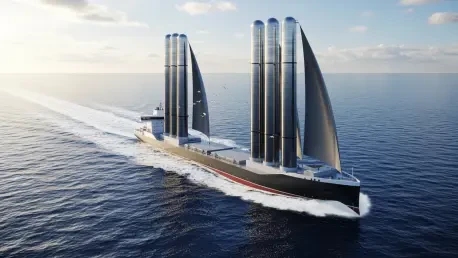Imagine a world where the shipping industry, responsible for nearly 3% of global greenhouse gas emissions, dramatically reduces its environmental footprint by reviving an ancient power source: the wind. This is not a futuristic dream but a current reality, as wind-assisted propulsion technology emerges as a game-changer in maritime transport. By blending time-tested sailing principles with cutting-edge innovation, this technology offers a powerful solution to cut fuel consumption and emissions, addressing both environmental concerns and strict regulatory demands. The spotlight shines on systems like VentoFoils, which are already transforming vessels into greener, more efficient machines.
Core Features of Wind-Assisted Propulsion Systems
VentoFoils: Modern Sails for a Greener Future
At the heart of wind-assisted propulsion lies the VentoFoil, a sail-like structure developed by Econowind, designed to harness wind power with remarkable efficiency. Standing at an impressive 16 meters, these foils are engineered to capture wind energy and convert it into thrust, significantly reducing fuel use for large vessels. Their sleek, aerodynamic design ensures minimal drag while maximizing power, making them a practical addition to modern ships seeking sustainability without sacrificing performance.
The effectiveness of VentoFoils is evident in real-world applications, such as their installation on the M/T Jutlandia Swan, a tanker operated by Uni-Tankers. This vessel, part of the oil and chemical transport fleet, showcases how such technology can reduce environmental impact in one of the most challenging segments of shipping. Early data suggests fuel savings of up to 10%, a figure that highlights the potential for widespread adoption across various maritime sectors.
Beyond raw performance, VentoFoils represent a symbolic shift in the industry’s mindset, proving that eco-friendly solutions can be both viable and economically beneficial. Their growing presence on over 130 vessels worldwide underscores a collective push toward cleaner shipping practices. This technology stands as a testament to innovation that respects both history and the urgent need for sustainability.
Seamless Integration into Existing Fleets
One of the standout advantages of wind-assisted propulsion systems is their compatibility with existing vessels, minimizing disruption to regular operations. A prime example is the swift installation of VentoFoils on the M/T Jutlandia Swan during a routine stop in Rotterdam, following preparatory work in Turkey. This process demonstrated how quickly and efficiently such systems can be retrofitted, ensuring that shipping schedules remain unaffected while embracing greener technology.
Safety remains a paramount concern, especially for vessels transporting hazardous chemical loads, and wind-assisted systems have been designed to meet stringent industry standards. Their integration does not compromise the structural integrity or operational safety of ships, a critical factor in gaining trust from fleet operators. This balance of innovation and reliability makes the technology appealing to a broad range of maritime stakeholders.
Moreover, the ease of adoption extends to operational logistics, as these systems require minimal changes to a vessel’s core functionality. Feedback from technical teams indicates that the learning curve for managing such systems is manageable, paving the way for broader implementation without necessitating extensive overhauls. This adaptability is key to scaling up adoption in an industry often resistant to change due to high upfront costs or operational risks.
Performance Analysis and Industry Impact
Real-World Efficiency and Compliance Gains
The practical benefits of wind-assisted propulsion are not mere speculation but are grounded in tangible results from pioneering adopters like Uni-Tankers. On the M/T Jutlandia Swan, the technology has delivered promising outcomes, with projections indicating a 10% improvement in fuel efficiency. Additionally, a 3% enhancement in compliance with European clean shipping guidelines positions this solution as a strategic asset for regulatory adherence in a tightening legislative landscape.
Other shipping companies have followed suit, integrating similar systems and reporting consistent gains in operational efficiency. These case studies collectively signal a broader industry shift toward sustainable practices, driven by both environmental responsibility and the economic incentive of reduced fuel costs. The ripple effect of such implementations is evident as more operators explore wind-assisted options to future-proof their fleets.
What sets this technology apart is its ability to deliver measurable impact without requiring a complete redesign of shipping infrastructure. The data from early adopters provides a compelling case for investment, particularly in segments like tanker transport, where environmental scrutiny is intense. As more performance metrics emerge, the credibility and appeal of wind-assisted propulsion continue to grow.
Industry Trends and Expert Insights
The maritime sector is witnessing a surge in eco-friendly innovations, with wind-assisted propulsion at the forefront of this transformation. Over 130 vessels equipped with VentoFoils reflect a growing acceptance, spurred by regulatory pressures and the economic benefits of lower operational costs. This trend aligns with broader industry goals to meet sustainability targets, especially within the tanker segment, which faces unique challenges due to the nature of its cargo.
Industry leaders, such as Econowind’s Chief Commercial Officer, Chiel de Leeuw, emphasize the technology’s expanding role in addressing specialized needs. Their expertise in tailoring solutions for diverse vessel types highlights a commitment to scalability and customization, essential for widespread adoption. Such insights reinforce confidence that wind-assisted systems can evolve alongside the industry’s changing demands over the coming years, from 2025 onward.
This momentum is further fueled by economic incentives, as fuel savings translate directly into competitive advantages for operators. Regulatory frameworks across Europe and beyond are increasingly favoring technologies that reduce emissions, creating a fertile ground for innovations like VentoFoils to flourish. The convergence of policy, economics, and technology paints a promising picture for the future of shipping.
Challenges in Adoption and Implementation
Operational and Technical Hurdles
Despite the clear benefits, integrating wind-assisted propulsion into maritime operations is not without challenges. Adapting to new systems at sea requires adjustments in vessel handling and maintenance routines, which can initially strain resources. Technical inconsistencies, such as variable wind conditions affecting performance, pose additional hurdles that demand ongoing refinement of the technology.
Crew training emerges as a critical factor in maximizing the potential of these systems, as highlighted by Uni-Tankers’ Technical Director, Kristian Larsen. Ensuring that personnel are well-versed in operating and troubleshooting wind-assisted mechanisms is essential for consistent results. Without adequate preparation, the risk of underutilization or operational errors could undermine the technology’s benefits.
Furthermore, the industry must address scalability concerns to apply this technology across larger fleets or diverse vessel types. While early implementations have been successful, replicating these results on a grander scale involves navigating complex logistical and financial considerations. Overcoming these barriers will require collaborative efforts between technology providers, ship operators, and regulatory bodies.
Market and Regulatory Barriers
Beyond technical challenges, market dynamics and regulatory frameworks present additional obstacles to widespread adoption. The upfront costs of installing wind-assisted systems, though offset by long-term savings, can deter smaller operators with limited capital. Financial incentives or subsidies may be necessary to level the playing field and encourage broader uptake in the sector.
Regulatory inconsistencies across regions also complicate the deployment of such technologies, as varying standards can create compliance challenges for international fleets. Harmonizing these guidelines will be crucial to ensure that wind-assisted propulsion is not hindered by bureaucratic discrepancies. Industry advocacy for streamlined policies could play a pivotal role in addressing this issue.
Lastly, market perception of emerging technologies often lags behind their proven capabilities, leading to hesitancy among conservative stakeholders. Building trust through transparent performance data and successful case studies will be vital to shift attitudes. As more operators witness the tangible benefits, resistance is likely to diminish, paving the way for mainstream acceptance.
Final Verdict and Path Forward
Reflecting on the journey of wind-assisted propulsion, it has become clear that this technology marks a significant step forward for sustainable shipping. The successful integration by companies like Uni-Tankers on vessels such as the M/T Jutlandia Swan demonstrates its potential to cut fuel use and emissions effectively. Performance metrics, coupled with growing industry adoption, solidify its standing as a credible solution amidst rising environmental pressures.
Looking ahead, the next steps involve focusing on scalability and accessibility to ensure that smaller operators can also benefit from this innovation. Collaborative initiatives between technology developers and policymakers could accelerate the creation of financial support mechanisms, easing the burden of initial investments. Additionally, investing in crew training programs promises to enhance operational efficiency and safety across diverse fleets.
A critical consideration for the future rests in continuous technological refinement to address variable performance under different conditions. Encouraging pilot projects on varied vessel types would provide valuable data to further refine designs. Ultimately, the path forward for wind-assisted propulsion lies in fostering an ecosystem of innovation, regulation, and education, ensuring that sustainable shipping becomes not just an aspiration but a tangible reality for the entire maritime industry.









